15 BRANDS: Milwaukee, Craftsman (made in China), Craftsman (USA), Channellock, Hazet, Bahco, Tekton, Gedore, Reed Tool, Kobalt, Crescent, Klein Tools, Irwin, Pittsburgh, Wera Joker, and Navegando.
Wrenches tested for resistance to self-adjusting during movement or vibration, wrench max torque before rounding ¾ inch nut, tool build quality both no load and under load and failure load.
I purchased all of the wrenches tested to ensure fair and unbiased reviews. So, thank you for supporting the channel.
Is a five-dollar adjustable wrench just as good as one that costs over fifty dollars? These wrenches are known for rounding off nuts and bolts, but is it possible that a good one is just as good as an open-end wrench? Well, let’s find out.
In the first test, we’ll see which wrenches back off when they experience movement. Then we’ll see if a vintage USA Craftsman wrench offers better-holding power on a nut than an imported Craftsman and 15 other brands. Then we’ll see which wrench is the strongest. All the adjustable wrenches we’ll be testing are 10 inches in length.
Crescent is Best in the test
Klein Tools is Best in the test but twice as expensive as the Crescent
Navegando
At a terrific price of only five dollars, this Navegando brand handles nuts and bolts up to an inch and a quarter, includes both SAE as well as metric markings, precision machine slide jaw, and worm gear allowing for fast fit and smooth adjustment, forged and heat-treated number 45 carbon steel.
The Navegando is made in China, and it weighs 426 grams. Adjustable wrenches with poor fit and finish will destroy nuts and bolts. The Navegando has 1.63 millimeters of up and down slop and 0.053 millimeters of side-to-side travel, which is suitable for a five-dollar tool.
A wrench with a lot of slop will self-adjust and back off with movement or vibration. So let’s see how much each wrench backs off when they experience vibration from a compact impact wrench for a fraction of a second. I’ll take the wrench to the test jig to keep it centered on the bolt, and the Navegando’s jaw opened up 8.5 millimeters.
Slowing things down, the worm gear backed off quickly as the excessive jaw movement sent the worm gear spinning.
Pittsburgh
At only six dollars, the second least expensive brand we’ll be testing is made by Pittsburgh and sold at Harbor Freight. Made of forged steel, Pittsburgh is made in China.
The Pittsburgh is slightly lighter than the Navegando at 422 grams, and the Pittsburgh has even more up-and-down travel than the Navegando at 2.1 millimeters and 0.66 millimeters from side to side. The worm gear grinds quite a bit as it turns, which helps keep it from backing off 1.57 millimeters.
Kobalt
For 29 dollars for three wrenches, or nine dollars each, is this Kobalt brand, drop-forged chrome vanadium steel for strength and durability, includes metric and SAE markings on the jaw, works with both standard and metric fasteners up to 1-3/8 inches.
The Kobalt is made in China and is the heaviest yet at 500 grams. The Kobalt has 1.85 millimeters of up-and-down slop and 0.3 millimeters of side-to-side slop, and the Kobalt performed much better than the Navegando and the Pittsburgh, with the jaws opening up 0.97 millimeters.
Tekton
For 15 dollars, this Tekton brand precision machine slide jaw and worm gear allows for exact fastener fit and laser-etched side markings in 1/16 of an inch or one-millimeter increments. The Tekton is made in China and is the lightest yet at 416 grams. The Tekton has minor up-and-down jaw travel at 0.93 millimeters and 0.25 millimeters of side-to-side travel. The Tekton jaws opened up 0.65 millimeters to move into the lead.
Crescent
For 18 dollars, this Crescent brand has a broader handle for more torque, an oversized knurl for more effortless adjustment, a tighter jaw fit, a hex jaw design that reduces slippage, and a tight grips bolt. We’re going to test that. Heat-treated forged alloy steel for toughness and durability, laser-etched scale, even includes an arrow for direction of use, one and three eighths-inch jaw capacity.
The Crescent brand is made in China, and it weighs 491 grams. The Crescent has 1.17 millimeters of up and down slop and 0.3 millimeters of side-to-side travel, and the Crescent did well, only opening up 1.02 millimeters, about the same as the Kobalt.
Craftsman
Also, for 18 dollars, this Craftsman brand, one-3 8-inch jaw capacity, includes both metric and SAE scales. The Craftsman is made in China and is the heaviest yet at 508 grams. The Craftsman has 1.11 millimeters of up and down slop and 0.18 millimeters of side-to-side, and the Craftsman performed about the same as the Crescent at 1.16 millimeters. Are USA-made Craftsman tools better than those made in China? We’re going to find out.
I bought this wrench on eBay; it’s advertised as new, and from the looks of it, it’s never been used, forged in the USA.
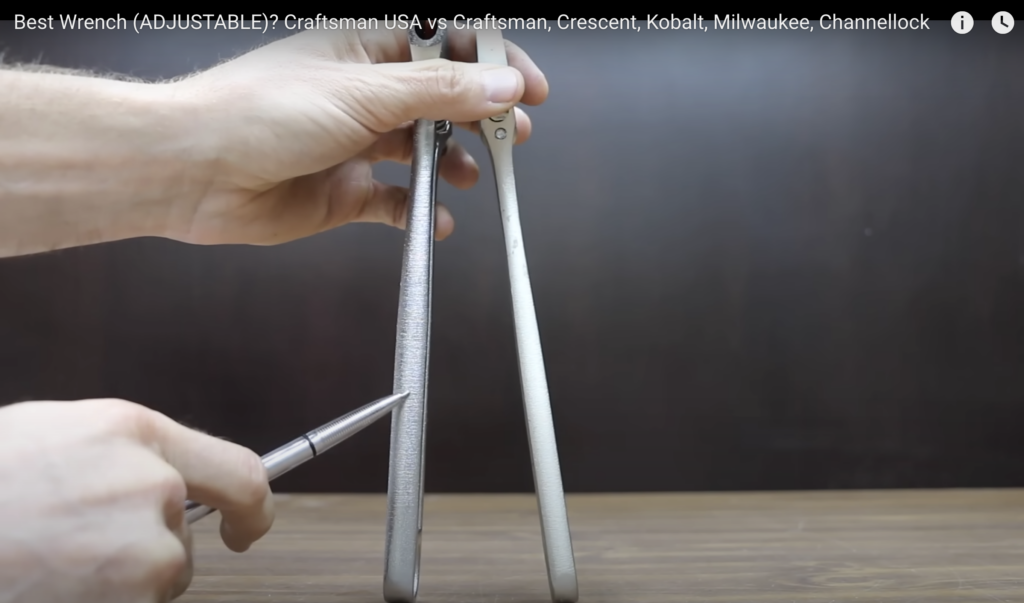
The Craftsman wrench on the left is made in China, and the one on the right is made in the USA. The wrench made in China is longer; it has a more oversized handle. The Craftsman, made in China, also has a wider jaw opening. The USA-made Craftsman is the lightest yet at 413 grams. The vintage-made USA Craftsman has far less slop than the other brands, at only 0.64 millimeters of up and down slop and 0.18 millimeters side to side.
And the Craftsman performed by far the best yet at only 0.35 millimeters, which is very impressive.
Irwin
Also, the price of twenty dollars, the same price as a Crescent and a Craftsman, is this Irwin brand. With machine jaws for maximum gripping strength, made of chrome vanadium steel, and a one-eighth-inch jaw capacity, the Pro Touch grip provides maximum torque and comfort. The Irwin is made in China, and it weighs 447 grams.
The Irwin Vice grips have 1.27 millimeters of up and down slop and 0.18 side to side, and the Irwin could have performed better than a Craftsman at 1.44 millimeters.
Channellock
For 29 dollars, this Channellock brand has a jaw capacity of one and thirteen thirty-seconds of an inch, longer jaws grip better, avoiding slippage or nut round-off, four-thread knurl measurement scales for SAE as well as metric, thinner jaws for greater access, and tight spaces, precision jaw design grips tight the first time.
The Channellock is made in Spain and is the lightest yet at 411 grams. The Channellock has a pretty good fit and finishes at 0.88 millimeters up and down slop and only 0.6 millimeters side to side. And the Channellocks perform nearly the same as the vintage Craftsman at 0.51 millimeters.
Reed
For 21 dollars, this Reed Manufacturing Company brand has a sizeable serrated knurl for smooth, easy jaw adjustment. The handle is up to 70% wider for more comfort and less hand fatigue, hex jaw design allows for a more secure fit. The Reed does not have size markings on the tool. The Reed brand is made in Spain and is light at only 370 grams, just like the Channellock.
The Reed wrench has a perfect fit and finishes at only 0.8 millimeters up and down slop and 0.6 millimeters side to side, just like the Channellock. The Reed wrench performed very well, only giving up 0.71 millimeters.
Klein Tool
For 36 dollars, is this Klein Tools brand? The knurl turns smoothly for easy operation, contoured handles for comfortable use, precision machine jaws are individually chosen and assembled by hand for smooth operation, and the highly polished chrome finish is rust-resistant. Made in Spain, the Klein Tools weighs 433 grams.
Klein Tools has more up-and-down slop than the Channellock, at 1.16 millimeters and 0.1-millimeter side to side. And the Klein Tools wrench gave up 1.2 millimeters.
Milwaukee
For 29 dollars, the same price as the Klein Tools is this Milwaukee brand, accurate size adjustment won’t dig into the palm, laser-etched ruler for easy to read, proprietary adjustment screw, and jaws won’t back off. We’re going to test that. Parallel jaws won’t slip or damage the finished surfaces.
The Milwaukee is made in Taiwan, and the Milwaukee weighs 491 grams. The Milwaukee has a six-thread worm gear, and the Milwaukee only has 0.71 millimeters of up and down slop and 0.13 millimeters side to side. Milwaukee claims their wrench won’t back off, and Milwaukee moves into first place, only giving up 0.27 millimeters, which is very impressive.
Gedore
For 44 dollars is this Gedore brand Swedish pattern roller with left-hand thread; it has a striking face to allow light blows, the jaw set is at 15 degrees, includes a metric scale. The Gedore brand is made in Germany, and the Gedore is the heaviest yet at 510 grams. The Gedore has 1.16 millimeters of up and down slop and 0.2 millimeters side to side, and the Gedore performed well, only giving up 0.69 millimeters.
Bahco
For 57 dollars, this Bahco brand extra-wide jaw opening, jaws with a shorter handle, precision-hardened and anti-corrosion-treated, slim head with tapered jaws, includes a measurement scale on the head of the tool, designed for maximum access in confined areas. Bahco is made in Spain; Bahco is by far the heaviest at 643 grams.
The Bahco only has 0.62 millimeters of up-and-down travel and 0.25 millimeters side-to-side, and the terrific fit and finish helped the Bahco move into second place, only giving up 0.3 millimeters.
Hazet
For 56 dollars, this Hazet brand laser-etched ruler for easy to read. While it’s not stamped on the tool, the Hazet is made in Germany, and milling data is transmitted directly to a high-speed milling machine. Spindle mills forged the contours with high precision at 42,000 RPM. Hazet weighs 438 grams.
The Hazet has 0.98 millimeters up and down slop and 0.15 millimeters side to side, and the Hazet performed very well, moving into fourth place behind the USA-made Craftsman at 0.38 millimeters.
Wera Joker
For 200 dollars for four of these wrenches, or 50 dollars each, is this Wera Joker. It takes four of these wrenches to achieve the same size adjustments as a traditional adjustable wrench. Most miniature wrenches are from 13 to 16 millimeters, then 16 to 19 millimeters, 19 to 24, and 24 to 32. Lift the head to open the jaws, automatically adjust to the proper size, and the ratchet function ensures a fast and consistent grip.
The Wera Joker is made in Germany. Wera Joker, that’s very close to the same length as the other brands is 379 grams.
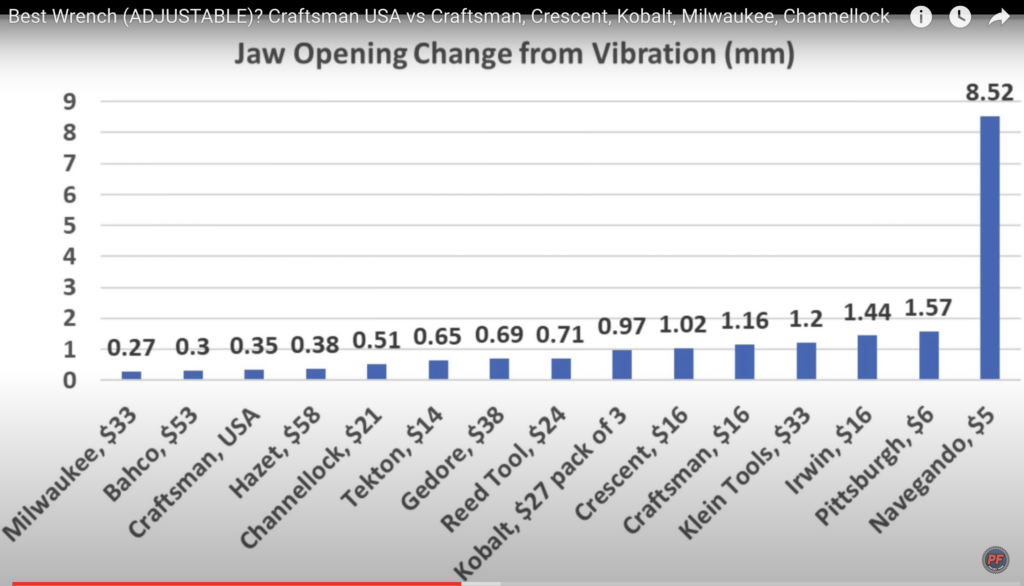
So Milwaukee came out on top, only giving up 0.27 millimeters; the Bahco also performed very well at 0.3 millimeters, USA-made Craftsman at 0.35, Hazet at 0.38, and Channellock at 0.51 millimeters.
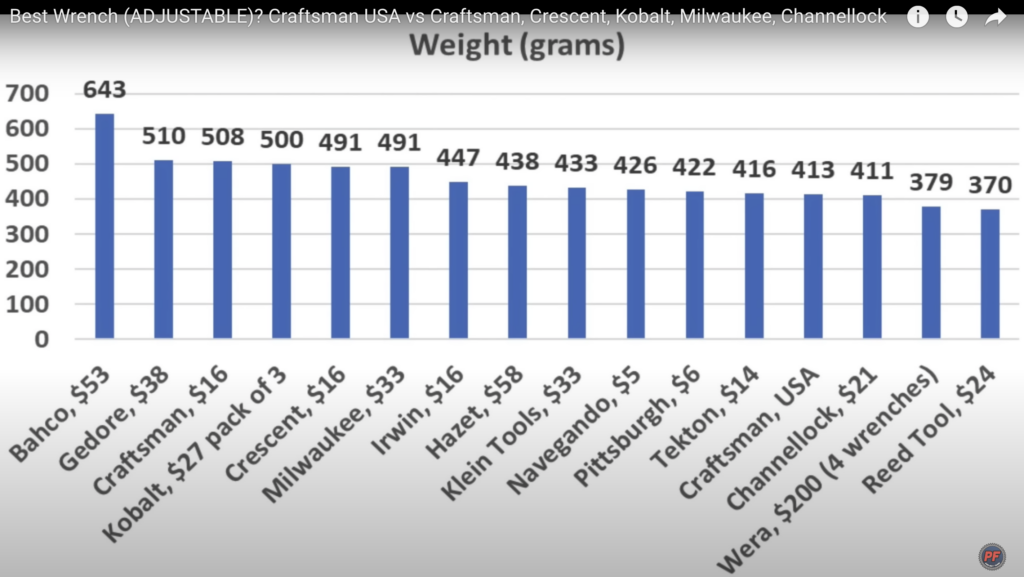
Tool weight is likely a factor in the next test, with the Bahco weighing the most at 643 grams. The Gedore is heavy at 510 grams, the imported Craftsman 508, Kobalt 500, and Milwaukee and Crescent 491 grams.
Let’s see how much torque each wrench can handle for the most crucial test before it rounds off a nut. The bolt passing through the tester will move freely. I’ll move the handles while tightening the worm gear to remove all the slack between the wrench and the bolt.
Once the wrench is in place, I’ll use a torque adapter and a breaker bar to apply force until the wrench loses grip. I’ll replace the nut with a new one between testing each wrench to serve as our control.
Let’s test a USA-made Craftsman wrench first. The three-quarter-inch Craftsman wrench is relatively narrower than the adjustable wrenches, and there’s a small gap between the jaws and the nut. 129.6 inch-pounds is the number to beat. Unlike the wrench, I can tighten the worm gear to press the upper and lower jaws against the nut tightly. The Navegando is off to a good start at 120.8 foot-pounds.
There’s a lot of movement with the worm gear and the jaws on the Pittsburgh, 105.2 foot-pounds, or 15 foot-pounds less than the Navegando. The jaws on the Kobalt and the worm gear experienced a small amount of movement and finally let go at 113.3 foot-pounds to move into the second-place position. And the Tekton has a lot less wobble than the Navegando, Pittsburgh, and Kobalt, and it refused to give up.
Minimal movement in the worm gear and jaws, and the Tekton finally gave up at 146.2 foot pounds. The Crescent brand knows something about adjustable wrenches, and the jaws and the worm gear did a terrific job of staying in position, and the wrench finally let go at 149.9 foot-pounds to move into first place. And the Craftsman brand, one of the heaviest wrenches tested, made it to 136.2 foot-pounds before giving up.
So the Craftsman moves into third place, behind the Tekton brand and the USA-made Craftsman. The worm gear and jaws are built like a tank, and the camera barely caught the torque reading before the half-inch-grade eight bolt finally snapped at 184.4 foot-pounds. Very impressive.
While the Craftsman didn’t wholly slip, there’s still some damage to the nut. And the Irwin has quite a bit of jaw wobble at 1.27 millimeters, which hurt the performance in this test. And there’s quite a bit of visible jaw stretching as the torque is applied, and the Irwin gave up at only 103.5 foot-pounds. While the Channellock has very little slop, the adjustable jaw doesn’t have a lot of strength as the torque is applied.
There’s a lot of visible jaw stretching, and the wrench gave up at 105.8 foot-pounds. As the torque is applied, the adjustable screw appears to be backing off slightly, and the Reed finished at 123.5 foot-pounds. While the Klein Tools wrench did have a bit more up-and-down slop than some of the other brands, the jaws, and the worm gear seem more robust than some other brands, and the Klein Tools brand performed well at 147.1-foot pounds.
The six-nurl worm gear in the Milwaukee didn’t move during the test. However, the jaw stretch is noticeable, and the wrench performed slightly better than average at 134.3 foot pounds. The Gedore had 1.16 millimeters of up and down slop, which has been a factor in how it performed in this test. The Gedore gave up at 131.6 foot-pounds, about the same as the Milwaukee.
The Bahco is huge and has little slop in the worm gear and the adjustable jaw. However, there is quite a bit of jaw stretch, and the Baco gave up at 132.9 foot-pounds, about the same as the Milwaukee and the Gedore. There’s nearly a millimeter of up-and-down slop with the Hazet, which has been a factor in how it performed as the torque was applied. The worm gear and the adjustable jaw began stretching at 125.2 foot pounds.
The Wera Joker has a unique design that applies proportionately more squeeze on the fastener as torque is applied to the handle. Unfortunately, the wrench suddenly flew off the tester, and that caused the torque adapter to suddenly power down. The torque reading was not stored in memory, but it does appear that the torque peaked at 167 foot pounds.
Unfortunately, the wrench broke during the test, so let’s test the smaller Wera Joker, which will also work with a three-quarter-inch nut. The Wera Joker reached 163.7 foot-pounds before the wrench finally began to lose grip. Unlike the giant wrench, the smaller wrench held up just fine.
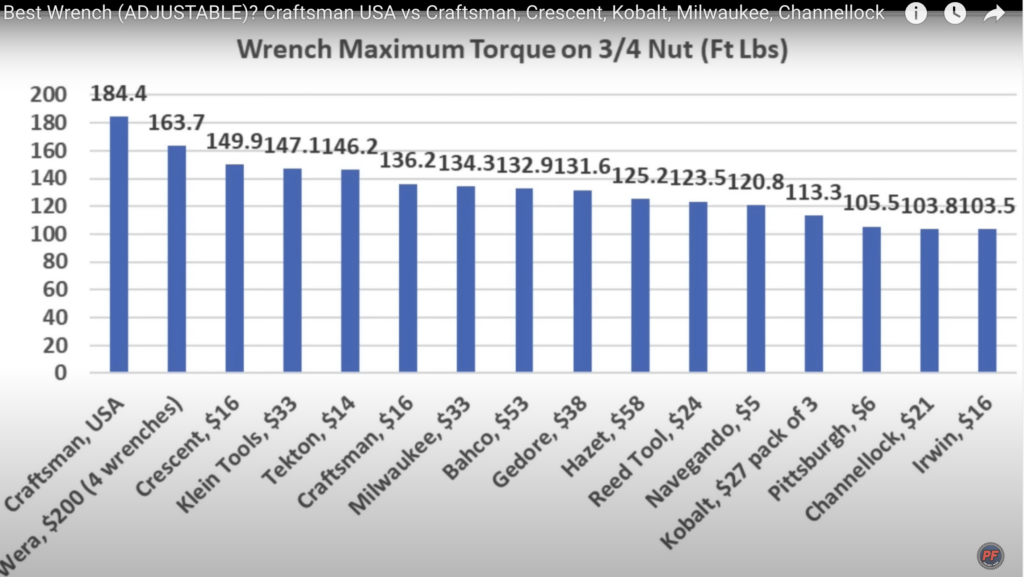
So the vintage Craftsman came out on top at 184.4 pounds before the bolt broke. The smaller Wera Joker wrenches also performed very well at 163.7 foot pounds. Crescent 149.9, Klein Tools 147.1, and Tekton 146.2 foot-pounds. A wrench with perfectly parallel jaws will make more surface area contact with a nut or a bolt than a wrench that’s not evenly aligned.
I applied up-and-down handle movement using this aluminum flat stock while tightening the worm gear to remove all the slop. Unfortunately, the Navagando jaws aren’t very parallel, and there’s a 0.045-millimeter gap between the wrench in the middle. Unlike the Navegando, the gap this time is on the inner side of the jaws. With the worm gear tight and snug, the Pittsburgh wrench has an even more significant gap than the Navegando wrench at 0.5 millimeters.
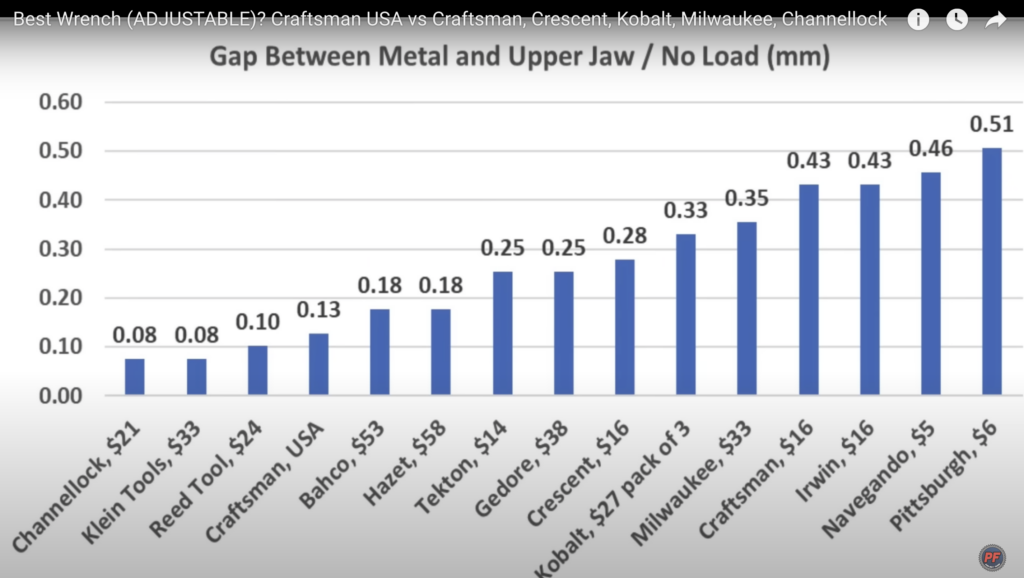
After measuring the no-load gap on all the brands, the Channellock and Klein Tools came out on top at 0.8 millimeters. But the Reed Tool wrench performed nearly as well at 0.1. Craftsman USA at 0.13, Bahco and Hazet at 0.18 millimeters.
I put together this next tester to measure the quality and performance of the wrenches under load. The steel plate across the top is made of AR500 to prevent the tester from bending or breaking. We’ve already measured the no-load gap, so let’s apply 200 pounds of load and measure the gap again. I’ll use a hydraulic press to apply the load, beginning with the Navegando.
Without a load, the Navegando had a gap of 0.45 millimeters. With a load, the gap between the jaws of the Navegando and the steel plate more than doubled to just over one millimeter. With around 200 pounds on the end of the handle, the gap with the Pittsburgh is 1.1 millimeters.
The Kobalt has a no-load gap of 0.33 millimeters, and the gap size more than doubled with 200 pounds of weight on the end of the wrench. The Kobalt performs slightly better than the Navegando at 0.88 millimeters. The Tekton has a no-load gap of 0.25 millimeters, and the gap size just about tripled to 0.76 millimeters under load.
So, Tekton does have the smallest gap and takes the lead from Kobalt, and the Crescent brand performed very well in the testing leading up to this point, and it performed very well in this test, too, with the smallest gap yet at 0.58 millimeters. The imported Craftsman’s build quality could be better than the Crescent brand, and the Craftsman left a gap of 0.7 millimeters.
With very short jaws from front to back, the USA-made Craftsman is at a leverage disadvantage, and the USA-made Craftsman overcame the leverage disadvantage and moves into first place over the Crescent with the smallest gap yet at 0.55 millimeters.
Unfortunately, the Irwin Vice Grip Ranch struggled and rounded off the nut at only 103.5 foot-pounds, and it struggled in this test at 0.75 millimeters. Unfortunately, the no-load gap grew 10-fold from 0.07 to 0.7 millimeters for the Channellock. Just like the vintage Craftsman, the Reed has very short jaws, putting it at a leverage disadvantage. It performed just as well as some wrenches with longer jaws at 0.7 millimeters.
The Klein Tools performed very well and didn’t slip and round off the nut until 147 foot-pounds, and it performed very well in this test, too, with the second smallest gap yet at only 0.65 millimeters. The Milwaukee had a no-load gap of 0.35 millimeters, and the gap size doubled under load to 0.75 millimeters, which is very close to average. The Gedore has a no-load jaw gap of 0.25 millimeters, and the gap size just about tripled to 0.7 millimeters under load.
The Bahco has the most extended jaws, which helped it in this test, with a gap of only 0.58 millimeters. The Bahco tied to the Cresent for second place. The Hazet has a no-load gap of only 0.17 millimeters, and it performed nearly as well as the Bahco, at 0.6 millimeters, with a 200-pound load.
Under 200 pounds, the wrench making the most contact with the nut is the Vintage Craftsman, with a gap of 0.55 millimeters. However, the Crescent and the Bahco performed nearly as well, at 0.58 millimeters, Hazard at 0.6, and Klein at 0.65 millimeters. Unfortunately, I’ve broken a lot of tools by pushing them past their limits.
We’ll see how much pressure they can handle if you use an adjustable wrench to apply leverage to flat or square stock. For safety reasons, I’ll be securing the wrench to the press and wearing a lot of protective equipment. Jaw length and build quality significantly impact performance, and the Navegando has a leverage advantage with longer jaws than average, making it to 750 pounds before the adjustable jaw breaks off.
Throughout the entire test of the Harbor Freight Pittsburgh, quite a bit of visible jaw stretching took place, and the Pittsburgh made it to around 600 pounds before giving up. Kobalt has quite a bit longer jaws than most of the other brands, and that helped it perform well in this test, finally coming apart at 940 pounds. The Tekton performed well throughout the testing, but the short jaws put it at a significant disadvantage, and the Tekton gave up at 581 pounds.
Like the Tekton, the Crescent has pretty short jaws, but it still performed very well, and the jaw finally snapped at 775 pounds. And the Craftsman’s long jaws give it a leverage advantage over the Crescent. However, the Craftsman gave up at around 656 pounds, or about 120 pounds less than the Crescent. The USA-made Craftsman has much shorter jaws than most other brands, putting it at a significant disadvantage.
Even with the leverage disadvantage, the Craftsman still performed well at 634 pounds. With the second-longest jaws in the lineup, Irwin benefited from the leverage advantage and moved into the lead at 1,179 pounds. Very impressive. And the jaw length of the Channellock is very close to the same as the imported Craftsman, and it gave up 10 pounds less at 646 pounds.
Even though the Reed has very short jaws, it performed well, reaching 687 pounds before busting loose and taking flight. The jaws on the Klein Tools wrench are shorter than average but still put up an above-average number at 731 pounds. And the Milwaukee weighs nearly 500 grams, and the jaws are longer than average, which helped it perform well in this test.
The worm gear is frozen at the top, and the lower jaws have bad bends. The Gedore’s jaw length is close to the same as the Milwaukee’s, and it performed well, reaching 961 pounds before snapping. And the Bahco has a seven-millimeter jaw length advantage over all the other brands, and the Bahco refused to give up but finally came apart at 1,334 pounds. Very impressive.
The Hazard’s jaws are slightly shorter than average, but it still performed better than average at 861 pounds.
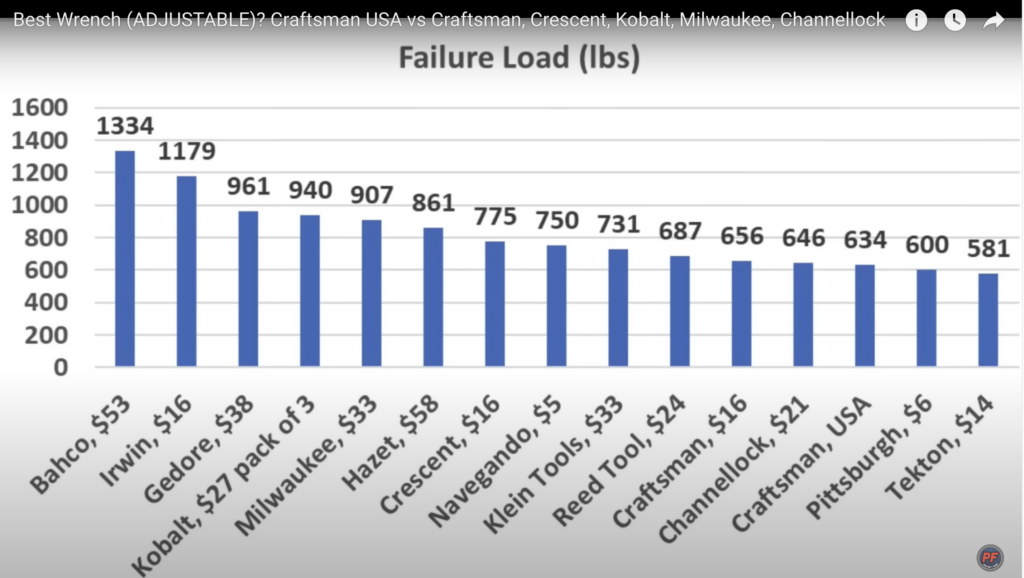
Conclusion
So if you’re looking for a wrench that can handle the most flat or square metal torque, the Bahco came out at 1,334 pounds. The Irwin also performed very well at 1,179 pounds, Gedore at 961, Kobalt at 940, and Milwaukee at 907 pounds.
And the wrench that performed by far the best in this showdown is the vintage Craftsman, made in the USA. But unfortunately, that wrench is no longer sold.
If I had to choose a wrench for under $18, I would go with the Crescent brand. It performed exceptionally well. If you want to spend more money, why not buy the Klein Tools? It, too, performed very well. But it’s $36.
I want to thank everybody for joining me for this showdown. I hope you enjoyed it as much as I enjoyed putting it together. If you like this test, please give me a big thumbs up, share it with your friends, and remember to subscribe. Thank you.

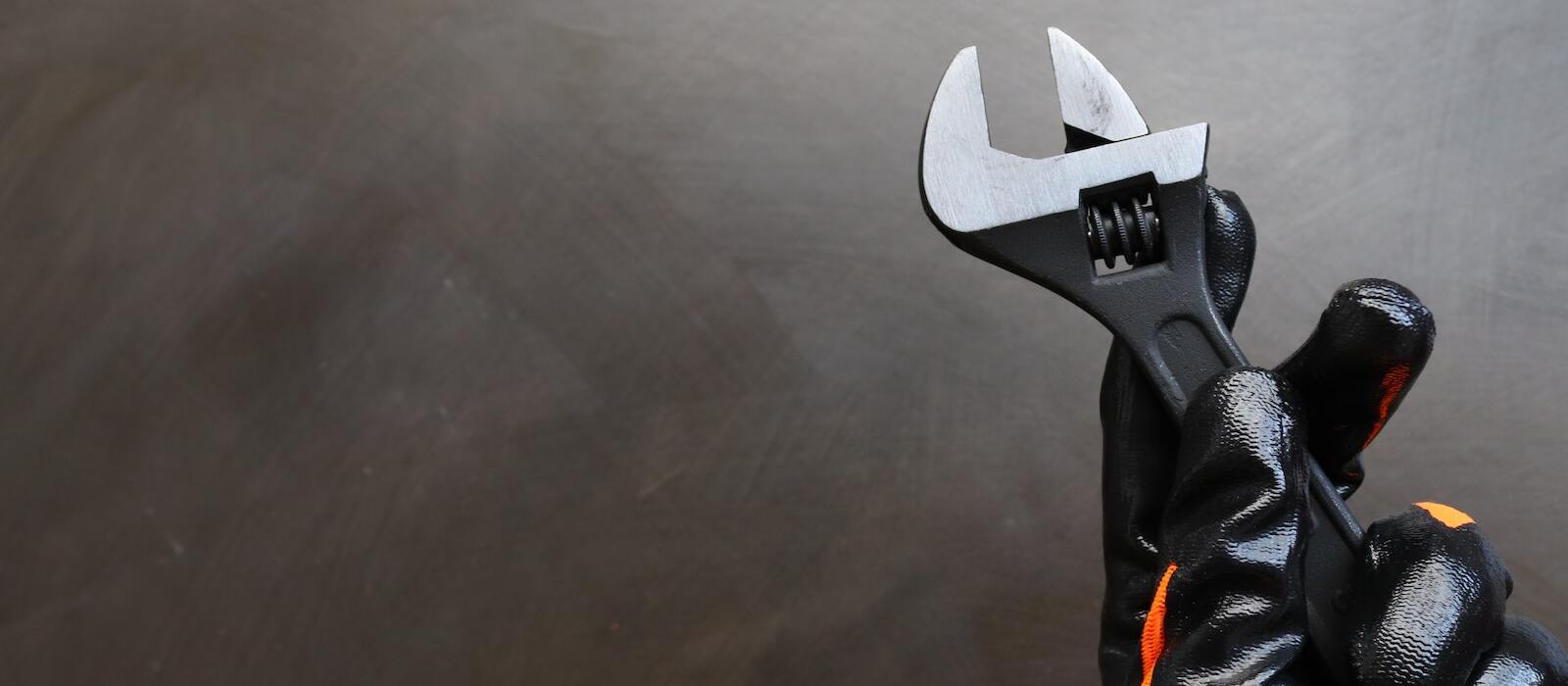













Leave a Reply